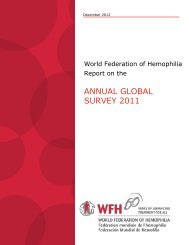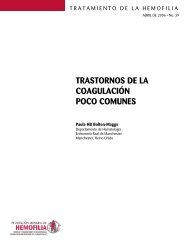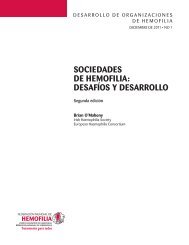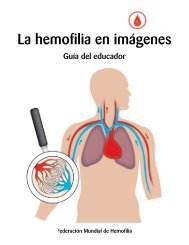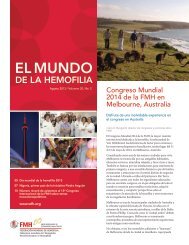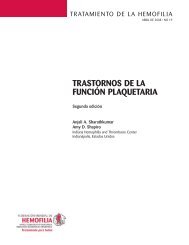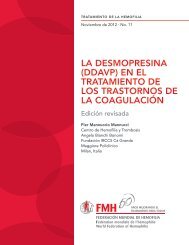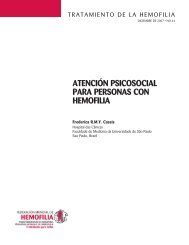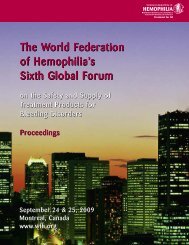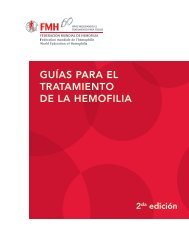Guide for the Assessment of Clotting Factor Concentrates
Guide for the Assessment of Clotting Factor Concentrates
Guide for the Assessment of Clotting Factor Concentrates
Create successful ePaper yourself
Turn your PDF publications into a flip-book with our unique Google optimized e-Paper software.
Plasma quality<strong>Factor</strong>s which have an impact on plasma quality and safety include:1) Plasma handling factors such as separation, storage, and transport, which also depend on<strong>the</strong> methods used <strong>for</strong> collecting plasma (recovered from whole blood or obtained byplasmapheresis)2) Donor epidemiology (viral infection, prion disease)3) Donor selection and testing procedures (including NAT) to reduce <strong>the</strong> window period <strong>for</strong>infection with different virusesAll <strong>the</strong>se factors affect <strong>the</strong> safety <strong>of</strong> fractionated plasma products with respect to transmissible infectiousagents. They also affect <strong>the</strong> yield and specific activity <strong>of</strong> products.Donor selectionDonor selection procedures are designed to identify and exclude donors at risk <strong>of</strong> being infected withviruses that can be transmitted by blood transfusion. In developed countries, donor selection procedureshave reached a high level <strong>of</strong> sophistication and complexity, and regulators have included <strong>the</strong>se proceduresin <strong>the</strong>ir assessment <strong>of</strong> overall safety <strong>of</strong> material used to manufacture plasma products.Exclusion criteria <strong>for</strong> donors used in different regulatory climates include:• History <strong>of</strong> blood-borne infections• Intravenous drug use• High risk sexual behaviour (male-to-male sex, prostitution)• Having received blood, tissues, etc.• Risky behaviour (tattoos, piercing, etc.)• Medical procedures, such as certain illnesses, surgery etc.Like all <strong>the</strong> measures described in this guide, <strong>the</strong> ability <strong>of</strong> different countries to implement <strong>the</strong>semeasures may vary. Each regulatory authority must assess a country’s local needs be<strong>for</strong>e mandatingspecific measures.Plasma typesPlasma types may be distinguished based on donor remuneration status (paid or unpaid) and method<strong>of</strong> collection (recovered or source plasma). Recovered plasma is a by-product <strong>of</strong> donated whole bloodand is generally procured from unpaid donors. Source plasma is collected from donors, most <strong>of</strong> whomare paid, through a process known as plasmapheresis, which removes only <strong>the</strong> donor’s plasma. Whencollected and processed with steps that exclude and inactivate or eliminate enveloped viruses (HIV,HCV, and HBV), both recovered and source plasma have <strong>the</strong> same level <strong>of</strong> viral safety in <strong>the</strong> derivedproducts.In <strong>the</strong> past, be<strong>for</strong>e <strong>the</strong> introduction <strong>of</strong> regulation in <strong>the</strong> blood sector, plasma <strong>for</strong> fractionation frompaid donors was considered to be <strong>of</strong> higher risk <strong>of</strong> viral infection than plasma from voluntary donorsdrawn from <strong>the</strong> same population. However, nowadays, in <strong>the</strong> developed blood systems <strong>of</strong> North Americaand Europe, this is no longer <strong>the</strong> case. This is <strong>the</strong> result <strong>of</strong> <strong>the</strong> strict regulatory regimens found in <strong>the</strong>seareas and <strong>the</strong> introduction <strong>of</strong> similarly strict industry standards. The inclusion <strong>of</strong> nucleic acid testing(NAT) <strong>for</strong> plasma <strong>for</strong> fractionation in <strong>the</strong>se systems has greatly reduced <strong>the</strong> viral load <strong>for</strong> HIV andHCV <strong>for</strong> all donor types. This equivalence in safety is not necessarily <strong>the</strong> case in o<strong>the</strong>r donor populations,4 <strong>Guide</strong> <strong>for</strong> <strong>the</strong> <strong>Assessment</strong> <strong>of</strong> <strong>Clotting</strong> <strong>Factor</strong> <strong>Concentrates</strong>



